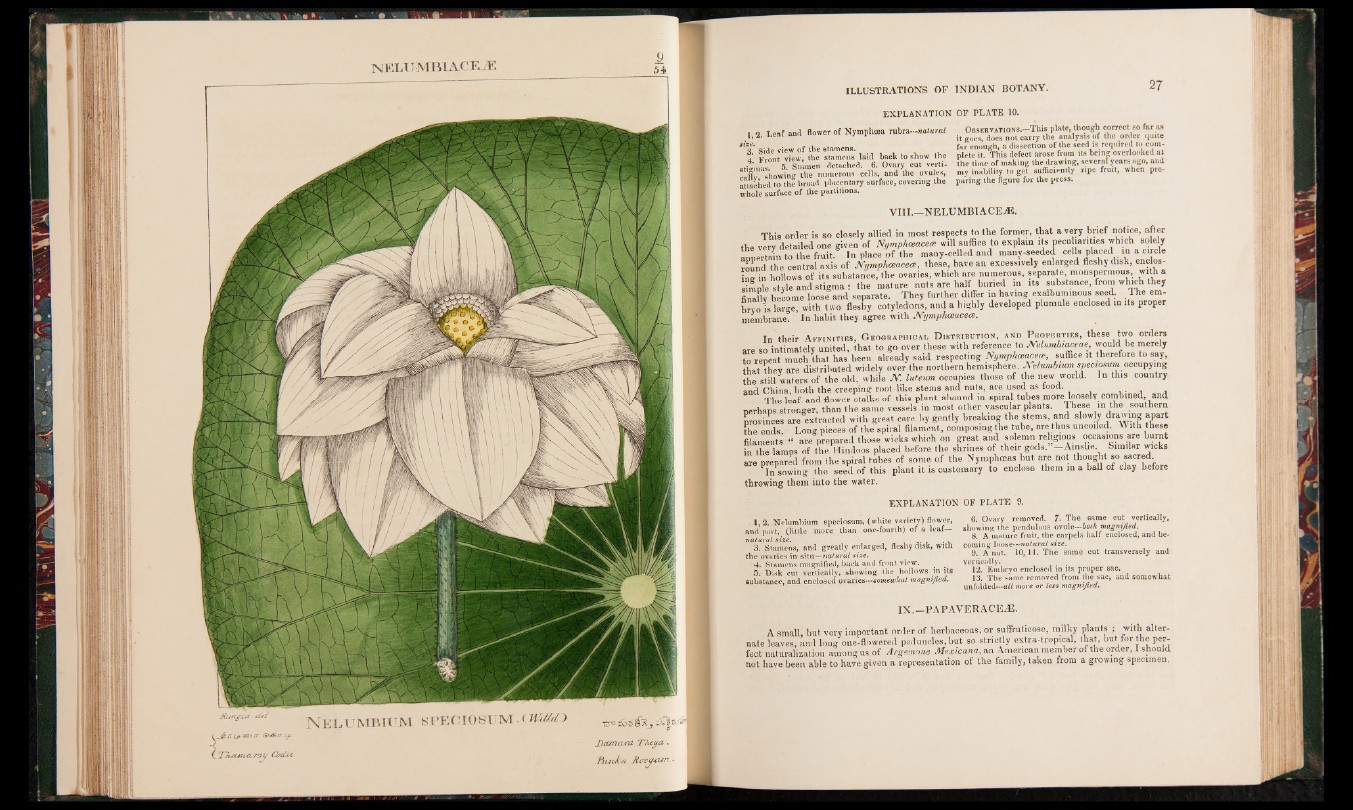
NELUMBIACEÆ
Jhuigût del
Æ i f <5TO rr (i>&rr Lp.
T'kasnct-rc/y Grdlc
NELUMBIüM s PECIOSÜM . ( WMd J rr® &>~6 j'O^g1^*w
DMncwu ThigM.
HttnJca Jlcrvqiun • I
EXPLANATION OF PLATE 10.
1 2. Leaf and flower o f Nymphoea rubra—natural
BBBS! . . 3. Side view of the stamens. .
4 Front view, the stamens laid back to snow tne
stiamas. 5. Stamen detached. 6. Ovary cut verti-
eallv showing the numerous cells, and the ovules,
attached to the broad placentary surface, covering the
whole surface of the partitions.
Observations.—This plate, though correct so far as
it goes, does not carry the analysis of the order quite
far enough, a dissection of the seed is required to complete
it. This defect arose from its being overlooked at
the time of making the drawing, several years ago, and
my inability to get sufficiently ripe fruit, when preparing
the figure for the press.
VIII.—NELUMBIACEvE.
This order is so closely allied in most respects to the former, that a very brief notice, after
the very detailed one given of Nymphceacea will suffice to explain its pecuhanties which solely
appertain to the fruit. In place of the many-celled and many-seeded cells placed in a circle
round the central axis of JYymphceacea!, these, have an excessively enlarged fleshy disk, enclos-
ine in hollows of its substance, the ovaries, which are numerous, separate, monspermous, with a
simp“e style and stigma: the mature nuts are half buried m its substance, from which they
f in X become loose and separate. They further differ g having exalbuminous seed. J he embryo
is large, with two fleshy cotyledons, and a highly developed plumule enclosed in its proper
membrane. ’ In habit they agree with JVymphceuceai.
In their A f f in it ie s , G eographical D ist r ibu t io n , and P ro p e r t ie s , these two orders
are so intimately united, that to go over these with reference to JVelumbiaceae, would be merely
to repeat much that has been already said respecting Nymphoeacea;, suffice it therefore to say,
that thev are distributed widely over the northern hemisphere AUumbmm speciosum occupying
the still waters of the old, while JV. luteum occupies those of the new world. In this country
and China, both the creeping root-like stems and nuts, are used as food. - ,
The leaf and flower stalks of this plant, abound m spiral tubes more loosely combined, and
nerhaps stronger, than the same vessels in most other vascular plants. These in the southern
Lvinces are extracted with great care by gently breaking the stems, and slowly drawing apart
the ends Long pieces of the spiral filament, composing the tube, are thus uncoiled. With these
filaments'“ are prepared those wicks which on great and so emn re igious occasions are burnt
in the lamps of the Hindoos placed before the shrines of their gods.”-Ainslie. Similar wicks
are prepared from the spiral tubes of some of the Nymphceas but are not thought so sacred
In sowing the seed of this plant it is customary to enclose them m a ball of clay before
throwing them into the water.
EXPLANATION OF PLATE 9.
1, 2. Nelumbium specioswn, (white variety) flower,
and part, (little more than one-fourth) of a leaf—
natural size.
3. Stamens, and greatly enlarged, fleshy disk, with
the ovaries in situ—natural size.
4. Stamens magnified, back and front view.
5. Disk cut vertically, showing the hollows in its
substance, and enclosed ovaries—somewhat magnified.
6. Ovary removed. 7. The same cut vertically,
showing the pendulous ovule—both magnified.
8. A mature fruit, the carpels half enclosed, and becoming
loose—natural size.
9. A nut. 10, 11. The same cut transversely and
vertically.
12. Embryo enclosed in its proper sac.
13. The same removed from the sac, and somewhat
unfolded—all more or less magnified.
IX.-PAPAVERACEÆ.
A small, but very important order of herbaceous, or suffruticose, milky plants ; with alternate
leaves, and long one-flowered peduncles, but so strictly extra-tropical, that, but for the perfect
naturalization among us of Argemone Mexicana, an American member of the order, I should
not have been able to have given a representation of the family, taken from a growing specimen.